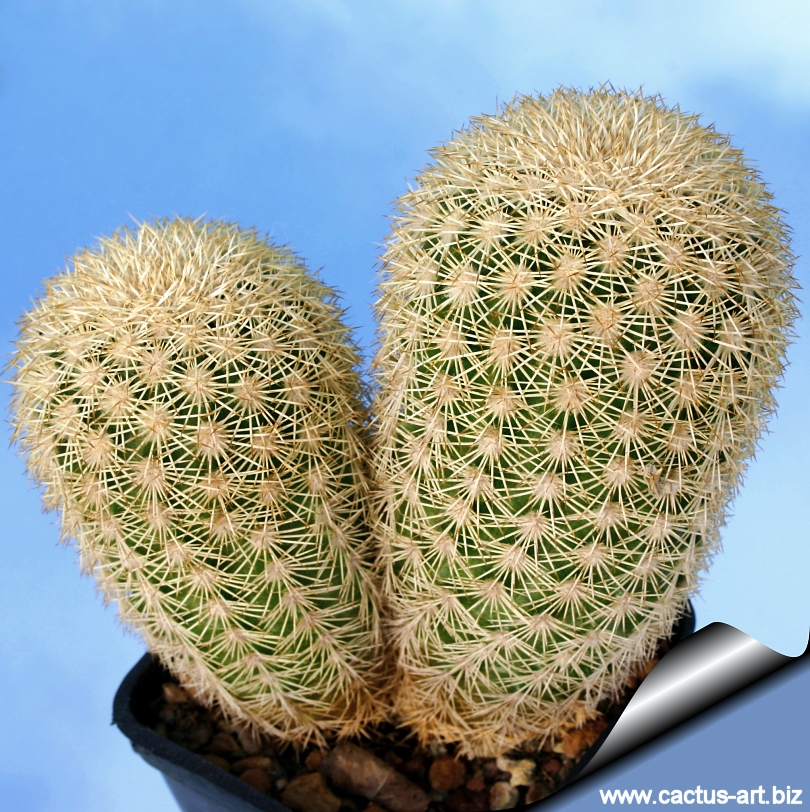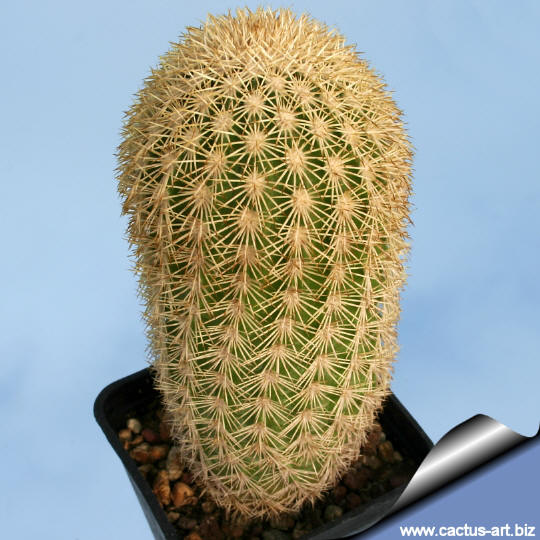|
|
|

Echinocereus grandis (San Estebán Island, Baia
California, Mexico)
It is one of the largest of the
upright-stemmed hedgehog cacti, it is not the longest-stemmed, but it is
the most massive. Plants in cultivation often grows for a long
time with single solitary columnar stems.
|
|
Description: Echinocereus grandis
is one of the largest of the upright-stemmed hedgehog cacti, It is
solitary, or occasionally branched to form small clusters up to 15
stems, the branches grows from the base. It is not the longest-stemmed,
but it is the most massive. The stems sometimes lay down under their own
weight. Plants in cultivation often grows for a long time with single
solitary columnar stems.
Stems: Sub-cylindric,10-50 cm tall, 8-12 cm in diameter.
Ribs: (18 to) 21 to 25 low.
Areoles: Large, elongated, close-set approx 1 cm apart.
Spines: Dull white to cream-colored quite short, spreading, and
stiff.
Central spines: Very slender light-colored 8 to 12 often in two
rows.
Radial spines: 15 to 25 radials, 1-10 mm long pressed next to the
skin.
Flowers: Diurnal, narrowly funnelform, white or pale yellow with
greenish base, unusually narrow, 5-8 cm in diameter, 5-7 cm long, near
the stem tips. The plants coming from San Lorenzo Island often have
rosy-coloured to pink/violet flowers. The pericarpel is densely covered
with straw coloured spines and white hairs. Filaments green, style
white, stigma lobes green. Floral remains are difficult to detach from
the plant and can set up stem rot.
Blooming season: It flowers annually in March-April, the
flowers remain open for 2 or 3 days. Blooming generally begins 7 to 10
years after sowing, as the plant matures.
Fruits: The fruits are very spiny.


|
|
Advertising
|
|
|
|
|
Family:
Cactaceae (Cactus
Family)
Scientific name:
Echinocereus
grandis Britton & Rose
Cactaceae 3:18. 1922.
E. grandis is very similar to
Echinocereus websterianus and some authors have linked these
two species, being uncertain of whether they are in fact one or two
species.
Etymology: Latin 'grandis',
large; for the large growth.
This species is very similar to
E. grandis and it is uncertain of whether they
are in fact one or two species.
Common English Names include:
Giant rainbow cactus, Giant
Hedgehog Cactus, San
Pedro Nolasco hedgehog cactus.
Origin: Mexico
(Gulf of California, several island in the sea of Cortez, San Estebán
Island, San Lorenzo Island, Nolasco Island and Las Animas ) It is
unclear though whether the plant is actually to be found growing on the
Baja California mainland, or whether it is only an islands based
endemic, like some other species. Type locality: San Esteban Island.
Habitat: Dry creek
bed, beach and low hills on the island
Conservation status: Listed in
CITES appendix 2.
Synonyms:
- Echinocereus
pectinatus var. grandis
|
|
Cultivation:
This cactus is
cultivated and highly
priced for its flowers and tall columnar
gold spined stems. It is among the
easiest species to grow, flower and propagate
but a slow grower. Water regularly from March to
October. Rot prone in winter, it needs good drainage. It
prefers a deep pot. It is though a holy terror when you attempt to repot
it, even the slightest touch seems to break off the spine clusters, a
very difficult issue to avoid if you are moving a larger plant!
Unfortunately, this tendency also permanently marks the plant and be
aware that such faults are not necessarily due to poor cultivation! but
in the greenhouse we will normally cut it and re-root its top when it
gets too long. The base, of course, will produce more pups which can
also be taken and re-rooted. It
require strong sunlight to maintain a healthy
appearance, and a
harsh "dry and cool" winter environment combined with maximum light
exposure enhances spring flower production. Avoid freezing
temperature. Propagation:
Seeds or cuttings if available.
Traditional uses:
Fleshy parts where used for candles.
|
|
|
|

|
|